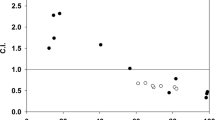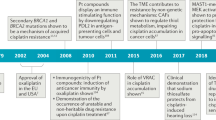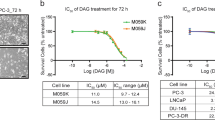Abstract
In DNA digested samples of CDDP sensitive (GLC4) and an 11-fold resistant (GLC4-CDDP) hSCLC line, the CDDP induced DNA adducts Pt-GG (Pt-(NH3)2d (pGpG], Pt-AG (Pt-(NH3)2d (pApG], G-Pt-G (Pt-(NH3)2d (GMP)2) and Pt-GMP (Pt-(NH3)3d GMP), were measured with polyclonal antibodies. The total amount of platinum (Pt) bound to DNA was also measured but with the help of atomic absorption spectroscopy (AAS). An increased net formation in GLC4 compared with GLC4-CDDP is found for the total Pt bound to DNA, Pt-GG and Pt-AG adducts after a 2 h 100 microM CDDP treatment. No significant difference is detected in the net formation of the Pt-GMP and G-Pt-G adducts. A slow Pt-AG adduct formation, with a maximum reached 10 h after CDDP composition, is found for both cell lines. In the 22 h period after the 2 h 100 microM CDDP treatment, a significant removal in GLC4 is measured for the Pt-GG, Pt-AG and the Pt-GMP adducts. For GLC4-CDDP a significant removal is detected in the total Pt bound to DNA, the Pt-AG and the Pt-GMP adducts. The removal of the total Pt bound to DNA in GLC4-CDDP cannot be explained by an adduct measured with the immunochemical method. In conclusion, no evidence is found that CDDP resistance is based upon the repair of the Pt-GG, Pt-AG, G-Pt-G and Pt-GMP adducts.
This is a preview of subscription content, access via your institution
Access options
Subscribe to this journal
Receive 24 print issues and online access
$259.00 per year
only $10.79 per issue
Buy this article
- Purchase on Springer Link
- Instant access to full article PDF
Prices may be subject to local taxes which are calculated during checkout
Similar content being viewed by others
Author information
Authors and Affiliations
Rights and permissions
About this article
Cite this article
Hospers, G., de Vries, E. & Mulder, N. The formation and removal of cisplatin (CDDP) induced DNA adducts in a CDDP sensitive and resistant human small cell lung carcinoma (HSCLC) cell line. Br J Cancer 61, 79–82 (1990). https://doi.org/10.1038/bjc.1990.18
Issue Date:
DOI: https://doi.org/10.1038/bjc.1990.18



